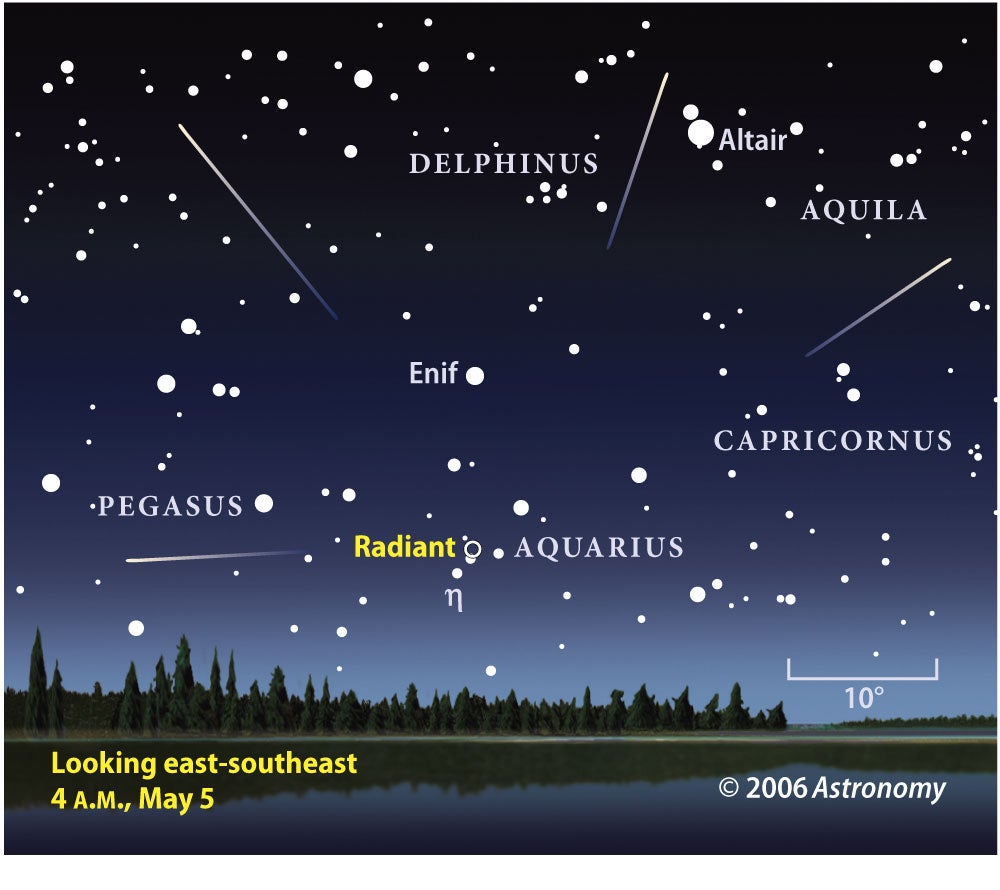
Matt Quandt
Assistant editor
[t] 262.796.8776 x419
[e] mquandt@astronomy.com
April 27, 2006
WAUKESHA, WI – Jupiter and shooting stars both put on great shows as spring temperatures warm the United States.
Ascending to his throne, the king of planets rules May nights. The giant planet Jupiter reaches opposition – the point in its orbit opposite the Sun as seen from Earth – May 4. On that date, it appears bigger and brighter than at any other time this year. The planet lies in the southeast as darkness falls and will be the brightest object in the sky until Venus rises before dawn. Its bright, steady light and pale peach color may disguise Jupiter to some as a distant plane’s landing light.
Throughout 2006, Jupiter looms in front of the stars of the faint constellation Libra the Scales. For observers in mid-northern latitudes, this means the planet won’t climb high in the sky. At opposition, Jupiter’s altitude maximizes at midnight (local time), when the planet stands about 40° above the horizon (roughly halfway up in the sky) in the south.
More Astronomy resources:
Astronomy news
This week’s sky events
Astronomy basics
Glossary of astronomical terms
Return to Astronomy “For the media” page
Looking at the planet through a telescope, you’ll first see a pair of dark stripes. These stripes – one above and one below the equator – are the North and South Equatorial Belts. Through larger telescopes and with higher magnifications, more dark belts and bright zones come into view.
Jupiter continues to be visible easily in the evening sky through October. Each evening between opposition and then, Jupiter appears slightly farther to the west. On November 21, Jupiter lines up with the Sun (a configuration called conjunction) and is invisible from our point of view.
Observers out admiring Jupiter may spot some shooting stars. These streaks of light are part of the Eta Aquarid meteor shower that peaks before dawn May 5. May’s meteor shower
During the early morning hours of May 5, the Eta Aquarid meteor shower peaks. Sharp-eyed observers at a dark site may see more than 30 shower meteors per hour.
The Eta Aquarids have that name because, if you trace all the meteor trails backward, they would meet within the boundaries of the constellation Aquarius the Water-bearer near the star Eta.
Meteors are small particles of rock and metal that Earth runs into during its orbit around the Sun. In space, these particles are called meteoroids. When they burn up in the atmosphere, they are called meteors. If they survive the fiery passage through our thick blanket of air and land on Earth, they are called meteorites. No meteorites are generated from meteor showers – the particles are too small.
Comets originate meteor showers. When a comet swings around the Sun, it leaves behind a trail of debris (small meteoroids). Sometimes, the orbit of this debris crosses Earth’s orbit. When our planet runs into this stream of particles, we experience a meteor shower.
The Perseid meteor shower’s particles come from Halley’s Comet. The comet releases the dust-size particles during its many trips through the inner solar system. Earth intersects the detritus each 7 years.
The Eta Aquarid’s radiant – the point where all the shower’s meteors seem to originate – rises about 2 hours before morning twilight begins. From the Northern Hemisphere, the radiant stands 20° high in the east-southeast at 4 a.m. local daylight time.
Observers should face east and look about halfway up in the sky. The best way to observe a meteor shower is to recline in a lawn chair. Don’t use binoculars or a telescope because they restrict the field of view.
The shower remains active from April 19 through May 28. As you observe on dates progressively further from the peak, you’ll see correspondingly fewer meteors. This year, the First Quarter Moon, which sets around 1 a.m. local time, doesn’t interfere with the prime viewing hours before dawn May 5.









